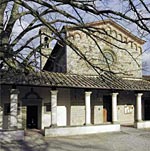
The ancient patrons are recalled by the coat-of-arms with epigraph to the left of the church’s portal, while the Medici armorial bearings are on two of the capitals of the façade’s portico as well as in the centre of it. Thus, the single hall church was enlarged by Michelozzo with a slightly raised presbytery (the four bays are covered by light cross vaults resting on corbels having a frieze decorated with the Medici balls, the bezants) and with a polygonal choir vaulted by five ribs. A bell tower was also built, the cloister redone, the ceilings of the sacristy and the chapter house renovated, and the number of cells was increased.
The church, dedicated to Saint Bonaventure, was endowed by Cosimo and later by his son Piero with splendid furnishings, like Fra Angelico’s altarpiece for the main altar (Florence, San Marco Museum) and the wooden crucifix from Donatello’s circle, now inside the convent. In 1532, Pope Clement VII had the refectory vaulted, while Grand Duke Ferdinando II, in 1626, had the monumental wooden altar built that now divides the presbytery from the choir behind.
These were the last important Medici commissions; then Pietro Leopoldo of Lorraine stripped the convent of its masterpieces, with the exception of the Crucifix. Today, 16th- and early 17th-century paintings, among which is the Allegory of the Cord of Saint Francis by Jacopo Ligozzi from 1589, adorn the walls of the church.
For information on visiting hours, telephone the convent on weekdays from 9 a.m. to 12 p.m. (+39055848111) or, again on weekdays, the Municipality of San Piero a Sieve (+39055848 7536).